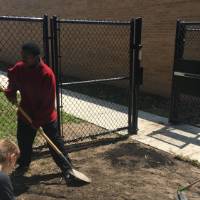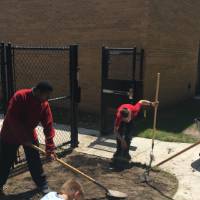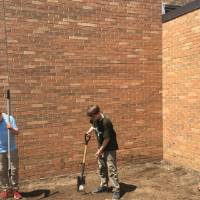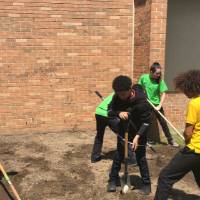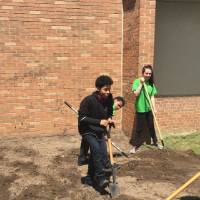C. A. Frost Middle/High
Project Description:
Fifth- through eighth-grade students learned the path water flows
in their local watershed starting from the school property. Various
onsite activities, along with trips to test the water quality of the
Brandywine Creek, Indian Mill Creek and the Grand River from downtown
Grand Rapids to the mouth of the river in Grand Haven, helped the
students to analyze the condition of the watershed. With this
knowledge, students designed and implemented best management practices
to help the community care for the watershed. Students hosted a
community Water Night and conducted site assessment at neighboring properties.
Fostering Lifelong Stewardship:
The students are able to educate others on the importance of
reducing nonpoint source pollution.
Partners:
Blandford Nature Center, LGROW
Teachers:
8
Students:
202
Funder:
National Oceanic and Atmospheric Administration
Showcase Video:
https://www.youtube.com/watch?v=j958xkPPuFA&t=1s
Project Description:
All grades, six through nine, participated in watershed
activities. As an introduction to their watershed, the sixth-grade
students boarded the GVSU research vessel in the fall, then focused on
identifying trees and reducing stormwater runoff the rest of the year.
The seventh-grade students focused on food and the impact of
agricultural practices on their watershed. The eighth-grade students
studied the condition of the Brandywine Creek through chemical and
biological analysis. The ninth-grade students designed and planted a
bioswale to help reduce runoff. Students also evaluated the chemical
and biological conditions of the Indian Mill Creek and the Brandywine
Creek. All students were involved in cleaning and marking storm drains
in the community. At the end of April, a water conference involving
sixth- and ninth-grade participants was held to educate the community
on ways to protect the local watershed. The sixth- and seventh-grade
students participated in a water-themed choir concert. Students wrote
statements about water protection and shared them during the
concert.
Fostering Lifelong Stewardship:
Students know the path of the water from the school property to
Lake Michigan and the importance of keeping storm drains clean to
reduce pollution. They can identify native plants, both woody and
herbaceous, that can be used in gardens to help reduce runoff.
Partners:
LGROW, Blandford Nature Center
Teachers:
3
Students:
180
Funder:
U.S. Environmental Protection Agency through the Michigan
Department of Environmental Quality
Showcase Video:
https://www.youtube.com/watch?v=g0-OekTT_g8
Project Description:
The sixth-grade students started the year with a trip on the GVSU
research vessel through the Annis Water Resources Institute. This trip
began the students’ watershed study for the next three years. In the
fall, the seventh-grade students hiked to Blandford Nature Center and
evaluated the plant biodiversity in the Brandywine Creek subwatershed
and also gathered seeds to plant at the new school. The eighth-grade
students started the year with a trip to downtown Grand Rapids to
evaluate the historical and current land use along the Grand River. In
March, the eighth-grade students took a bus tour of the Indian Mill
Creek to evaluate the land use within their subwatershed. The
tenth-grade students participated in the River Rally held in downtown
Grand Rapids (four of the tenth-graders presented at a workshop).
To help educate the school and local community, students held the third annual “Water Night” event. Every eighth-grade student created an interactive display for participants to do something to learn about the watershed and the effects of nonpoint source pollution.
Based on the watershed yearlong study, including where the water goes on our new property, the eighth-grade students determined the best location for installing a native garden to help reduce runoff. Students created proposals, worked with soil experts to evaluate the soil in the proposed area, designed the garden with the available plants, and prepped the soil using hand tools. Students then planted, mulched, and watered the plants throughout the summer.
Fostering Lifelong Stewardship:
Students can evaluate their own properties to determine best
management practices that would reduce pollution entering the watershed.
Partners:
LGROW, Chris Olsen, Graphic Designer, Cervas Screen Printing, 3P
Printing, United States Department of Agriculture
Teachers:
7
Students:
227
Funder:
U.S. Environmental Protection Agency through the Michigan
Department of Environmental Quality
Showcase Video:
https://www.youtube.com/watch?v=0wBcKOk6Wcg
Project Description:
Through student evaluation of the movement of water on our school
property, students identified areas that needed immediate attention.
Students selected two locations on school grounds and made plans to
help rainwater stay on school property and increase native habitats.
The first area students identified was the school courtyard. This area flooded, so students designed and planted a native garden on the northwest wall of our enclosed courtyard to improve infiltration and to help feed native wildlife such as birds.
The second area students identified was the outdoor classroom. Students evaluated the flooding in the area, then designed and planted a garden on the south side of the outdoor classroom to reduce the flow of water from its roof into the stormdrain. This project was a continuation of the previous year's project and may be the last garden needed for this area.
Fostering Lifelong Stewardship:
Students know the importance of using native plants to reduce
runoff and keep water where it lies. They also learned how to design
and make a garden. With this knowledge students are able to create
native landscapes at home and lead garden development within their
school community.
Partners:
WMEAC, DEQ
Teachers:
7
Students:
119
Funder:
GVSU College of Education
Showcase Video:
https://www.youtube.com/watch?v=PAJsRf5I6pM
Project Description:
Frost Middle/High is in its third year of existence, and the
campus landscape has been neglected for much longer. We have several
acres of woods, along with open space adjacent to our building, but
the woods are mostly overgrown and inaccessible and the open space is
mainly turfgrass. While our natural assets on campus could provide
high-quality green spaces for studying and enjoying nature, their
current conditions inhibit those experiences.
Frost students in grades 6-12 studied our degraded landscape and
planned and implemented restoration activities in fall 2018 and spring
2019. Activities included assessing and mapping existing natural
assets, cataloging native and invasive plants, soil analysis, and
other activities to study the ecology of our campus. Students used
this information to plan and implement restoration activities, which
ensured that student voice was incorporated into project outcomes.
Restoration activities included: removing invasive honeysuckle and
garlic mustard, installing a native plant pollinator and songbird
garden, building trails to increase accessibility to wooded areas,
mitigating poison ivy problems, and improving existing rain gardens.
In addition, we continued an effort to daylight a stream that is
currently underground in gray infrastructure. This project began in
partnership with the Grand Valley Metro Council (GVMC) and Kent County
Office of the Drain Commissioner, but no movement has occurred in
recent months. While the daylighting project is clearly beyond the
scope of a Groundswell project alone, we plan to incorporate our
restoration activities into a long-term vision that includes stream daylighting.
Fostering Lifelong Stewardship:
Since students go to school at CA Frost and enjoy the use of this
space, they have a stake in the improvement of the neglected green
space that is the “Frost Forest.” This design and building process
will help to empower students as they see their designs unfold for
their use, the local neighborhood’s use, and the betterment of the
local environment. In addition, students have had meaningful watershed
learning experiences, which give them a better understanding of their
roles in the Great Lakes ecosystem.
Partners:
Plaster Creek Stewards, Grand Valley Metro Council / Lower Grand
River Organization of Watersheds, GVSU Sustainable Agriculture Project
Teachers:
4
Students:
240
Funder:
National Oceanic and Atmospheric Administration
Showcase Video:
https://youtu.be/vrzrpMB9tKw
Project Description
C.A. Frost Middle and High School students have launched a multiyear stream and landscape restoration project in our wooded area on campus. As a result of a partnership between our school, the school district, City of Grand Rapids, Grand Valley Metro Council, and Kent County Office of the Drain Commissioner, the first phase of the stream daylighting project was completed in August 2020. A section of storm sewer 300 feet long was unearthed, revealing an open stream. The current state of the project is like a blank slate. We have a new stream, bare stream banks, and one acre of natural floodplain that was previously wooded.
Frost students are now leading all aspects of the project. They are doing basic science work, such as water and soil investigations and biodiversity assessments, to learn more about the site. Students are using this data to plan and implement appropriate restoration activities. For example, students are creating plans to stabilize the stream banks by installing native plants suited to wetland and upland zones of the stream banks.
Our overarching goal for this project is to improve the aquatic and terrestrial habitats in order to increase biodiversity in our local ecosystem. The project is in an early phase and will continue for years, making it a long-term and process-based experience for students. Realistically, this spring we hope to begin installing native plants along the stream, rebuild the trail that was lost to the heavy equipment work last summer, and figure out how to improve the new floodplain adjacent to the stream.
Partners:
City of Grand Rapids, Grand Valley Metro Council, Streamside Ecological Services, Plaster Creek Stewards, Kent County Office of the Drain Commissioner
Teachers:
Micah Herrboldt, 6-8th grade
Environmental Science; Dave Kraff, 9-12th grade Environmental Science;
Bill Smith, 9-10th grade Biology & Environmental Science
Students:
334
Funder:
Baldwin Foundation, EPA Great Lakes
Restoration Initiative grant, Grand Rapids Public Schools (match
funds) Grand Valley Metro Council (match funds)
Showcase Video:
High School: https://www.youtube.com/watch?v=SPTTOTadGsw
Middle School: https://www.youtube.com/watch?v=9ZdXb6Gym9I
Project Description:
C.A. Frost Middle and High School students have launched a multiyear stream and landscape restoration project in our wooded area on campus. Our main focus this year is participation in the Blue Crew [NOAA BWET] coordinated water quality monitoring program. We have begun monitoring work on our newly daylighted stream on campus. Our lens for this work is to explore how land use in the local watershed affects water quality in the stream. Students designed and implemented their own water quality research projects, applying what they’ve learned through Blue Crew activities. Some of these research projects will be continued by different student groups in subsequent years, creating long-term research projects housed at our school.
In addition, students continued our native plant propagation project, which was launched last year with Groundswell funds. We harvested and sprouted seedlings this year. We installed native plants this spring, with the goal of improving water quality in our stream. The water monitoring and native plant projects complement one another, enabling students to both measure water quality and implement strategies aimed at improving it.
Fostering Lifelong Stewardship:
Students have a deeper understanding of their own ability to keep waterways clean, even our little stream on our property. Students are taking a deep dive into water quality research and learning strategies to improve water quality. Students will gain a better understanding of how human activities affect water quality, and hopefully their work and experiences translate to lifelong stewardship - especially if they see that their work can make a difference.
Partners:
Lower Grand River Organization of Watersheds, Grand Valley Metro Council, Plaster Creek Stewards
Teachers:
Micah Herrboldt, 6th, 7th, & 8th, Environmental Science; Dave Kraff, 9th-12th Grade, Environmental Science
Students:
290
Funder:
NOAA BWET
Showcase Video:
High School (Kraff): https://www.youtube.com/watch?v=LM-SGMASR5M&list=PLV2DqaYFEsPwEUUHkVf4EWeARMMgZa9NL&index=27
Middle School (Herrboldt): https://www.youtube.com/watch?v=ifwKJA2xGQc&list=PLV2DqaYFEsPwEUUHkVf4EWeARMMgZa9NL&index=29
Project Description:
Our 2022-2023 project focuses on two related areas: 1) performing place-based environmental investigations in and around campus, and 2) launching BidaLosa, a student-run native plant company aimed at mitigating environmental problems discovered as a result of student investigations.
First, students are performing a range of scientific investigations on and near school grounds and waterways. Topics explored so far this year include: indoor and outdoor air quality, lichen investigations, soil analysis, aquatic macroinvertebrate populations, and others. Upcoming spring investigations will explore water quality and carbon cycling, as well as student-designed investigations of choice. All year, students are discovering different environmental problems and analyzing possible solutions to problems they find.
Second, students are working with Junior Achievement to launch BidaLosa, a student-run native plant company. Students are learning all aspects of forming and operating a business, including financials, branding, marketing, sales, and other topics. Using our classroom and greenhouse, students are in the process of propagating native plants from seed they harvested at The Highlands last fall. Their main plan for BidaLosa involves two goals: 1) installing native plants on campus to mitigate environmental problems, and 2) having a plant sale this spring. In addition, students are selling packets of extra seed harvested at The Highlands.
Fostering Lifelong Stewardship:
Students are learning how human activities impact the landscape, waterways, and airsheds in the Great Lakes region. They form their own research questions and analyze meaningful data. By exposing students to a wide range of environmental topics - spanning water, air, soil, and more - hopefully they will find something that sparks their individual curiosity and interests. I aim for them to always remember how to be a scientific thinker about their planet.
Partners:
Junior Achievement, Plaster Creek Stewards
Teachers:
Dave Kraff, Environmental Science, 9th-12th Grades
Students:
75
Funder:
Grand Rapids Public Schools, Wege Foundation
Showcase Video: https://youtu.be/aJu9mCts4MY
Project Description:
Students implemented the project described above: landscape restoration adjacent to the daylighted stream and growing native plants. Students installed 20 trees near the stream, put down cardboard to kill invasive plants for the meadow installation, propagated more than 3,800 native plants from seed they harvested locally, and installed two pollinator gardens in the school parking lot. The project will continue in the fall by planting the meadow with leftover wildflower seed and installing more pollinator gardens with plant plugs.
Fostering Lifelong Stewardship:
Students learned how to transform a landscape in order to increase local biodiversity. Hopefully will cause them to care more about these projects in the future. Propagating native wildflowers is difficult compared to many other types of plants, so this process should build their confidence to grow all different types of plants in the future. Also, students gained entrepreneurial skills that might carry over to their professional lives in the future.
Partners:
Kent County Drain Commissioner’s Office, KCD - Kent Conservation District
Teachers:
Dave Kraff, Environmental Science, 9th-12th Grades
Students:
55
Funder:
Grand Rapids Public Schools, Great Lakes Fishery Trust
Showcase Video: https://youtu.be/HJF4MpxtEqA?feature=shared
Project Description:
Students in environmental science and Junior Achievement classes are leading a long-term ecological restoration of campus natural areas, combining hands-on habitat improvement—like stream daylighting, pollinator gardens, and invasive species management—with scientific monitoring to track ecological change. Through a student-run native plant business, they propagate and sell thousands of native plants annually, supporting local restoration projects and gaining real-world entrepreneurial experience.
Partners:
Eco-EE, Designs by Nature
Teachers:
Dave Kraff, 9th - 12th
Students:
54
Funder:
Great Lakes Fishery Trust
Showcase Video: https://youtu.be/-elvJWeIEp8?feature=share

